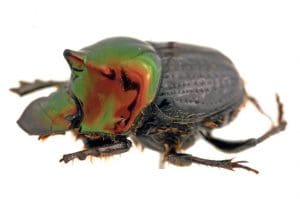
Dung Beetle Solutions Australia co-principal Dr Bernard Doube. Picture – DBSA.
SHEEP and beef producers are expected to reap significant internal parasite control advantages, including potentially minimising worm drench use, from a dung beetle project announced this week.
Two new species of dung beetles from southern Europe will be released in the five-year $23.7 million project that will involve a roll-out of national and region-specific dung beetle services to more 1000 livestock producers and groups in South Australia, Victoria, Tasmania, New South Wales and Western Australia.
Deputy Prime Minister and Minister for Agriculture and Water Resources, Barnaby Joyce, and the Member for Page, Kevin Hogan announced on Monday that Meat & Livestock Australia will receive $9.2 million under Round 3 of the Rural Research and Development for Profit Programme for the project.
The dung beetle project will look at ways to increase farm productivity and profitability by harnessing the potential of dung beetles as ‘ecosystem engineers’, to improve soil health, reduce the spread of flies, pests and diseases, increase pasture health and reduce nutrient run-off into waterways.
Click here to get the latest Sheep Central story links sent to your email inbox.
New species of dung beetle being mass-reared

A male Onthophagus vacca dung beetle. Picture CSIRO
Dung Beetle Solutions Australia principals Bernard and Loene Doube have been mass rearing two new species of spring-active in South Australia — Bubas bubalus and Onthophagus vacca — for field trials next spring.
“Both of these species are going to do very well in sheep and cattle dung.
“That is in marked contrast to all but one of the other 23 species that we have introduced to Australia since the 1960s as part of the CSIRO dung beetle program,” Dr Doube said.
“They are going to have two major benefits; one is improved pasture production, but the second is breaking the parasite cycle,” he said.
“Although we haven’t done the experiments with high beetle numbers, we’ve done them with low beetle numbers, and it seems that the drying out and burial of the dung is going to make a major contribution to solving the intestinal parasite problems with sheep in southern Australia.
“I wouldn’t be surprised if drenching in 20 years if drenching is a rare thing in many of these places,” Dr Doube said.
He said there is widespread worm resistance to chemicals used in sheep and it was getting worse.
“I think that is one of the under-sold major benefits that is going to flow from this dung beetle project.”
Beetles to have bush fly and water quality benefits
Apart from assisting in breaking the life cycle of internal cattle parasites, the project is expected to aid in bush fly control for beef and dairy producers and have major environmental benefits by the burying of dung that could pollute waterways, Dr Doube said.
“So there is going to be a major increase in water quality as the dung beetle tunnels allow water into the soil rather than flowing off, reducing the amount of run-off and purifying the water.
“It is a cleansing procedure in a number of ways.”
Dr Doube said the project would also involve the importation of additional dung beetle species into Australia. He is in contact with people in South Africa and Montpellier in France to select new dung beetles.
“At least four species will be brought into Australia over the next five years.”
Dr Doube said his intent was to have dung beetles that can work across Australia in all seasons.
“Another component of this project will be defining the current gaps in dung beetle distribution.
“Although we have dung beetles working very well in some situations, there are many situations in which they are relatively scarce or absent.”
Australia also has about 480 species of native dung beetles that work on kangaroo droppings.
MLA to work with 12 project partners
Mr Joyce said the humble dung beetle can deliver big benefits on-farm, including improving soil and pasture health, reducing the spread of flies, pests and diseases, and reducing nutrient run-off into waterways.
“No wonder the ancient Egyptians gave them a sacred status.
“This project will help farmers unlock the potential of these powerful ‘ecosystem engineers’ to increase productivity and reduce the costs of production, effectively turning dung into dollars.”
He said MLA will collaborate with 12 project partners with the shared goal of realising the value of the 80 million tonnes of dung produced by Australian livestock every year.
“Rural R&D for Profit Programme funds projects that deliver practical and accessible results for farmers, including managing pests, better pasture management and production techniques and improving access to premium markets.”
Mr Hogan said the project had the potential to deliver exciting benefits for Australia’s $23 billion livestock industry.
“This project will involve the roll-out of national and region-specific dung beetle services to a network of over 1000 producers and producers groups.
“These groups will have access to information such as a dung beetle database, infield training and online education packages to help select the more beneficial dung beetle species for their farm.”
The CSIRO’s 1965-1985 Dung Beetle Project successfully introduced 23 species of South African and European dung beetles to Australia, improving the quality and fertility of Australian cattle pastures, and reducing numbers of pestilent bush flies by around 90pc. The American Institute of Biological Sciences estimates that dung beetles save the US cattle industry an estimated US$380 million annually.



The soil food web in which the dung beetle operates is a highly complex biological system which is impacted by a wide range of livestock management, pasture management and climate factors. To suggest introducing new species of dung beetles on their own are going to make a quantum difference to soil health is fanciful when best practice grazing management is already being implemented. The same goes for sheep and cattle infective worm larvae populations on pastures. There are a host of factors influencing larvae populations and potential for livestock to ingest them. To simplify infective larvae control down to introducing new species of dung beetles is “silo” thinking. Successful worm larvae control programs employ an integrated worm management strategy. Dung beetles can be an additional component of such a program, not a substitute for an integrated approach. Perhaps part of the $23.7million should be allocated to more holistic extension surrounding pasture management to minimize worm larvae ingestion while at the same time improve pasture productivity and resilience in face of variable rainfall?